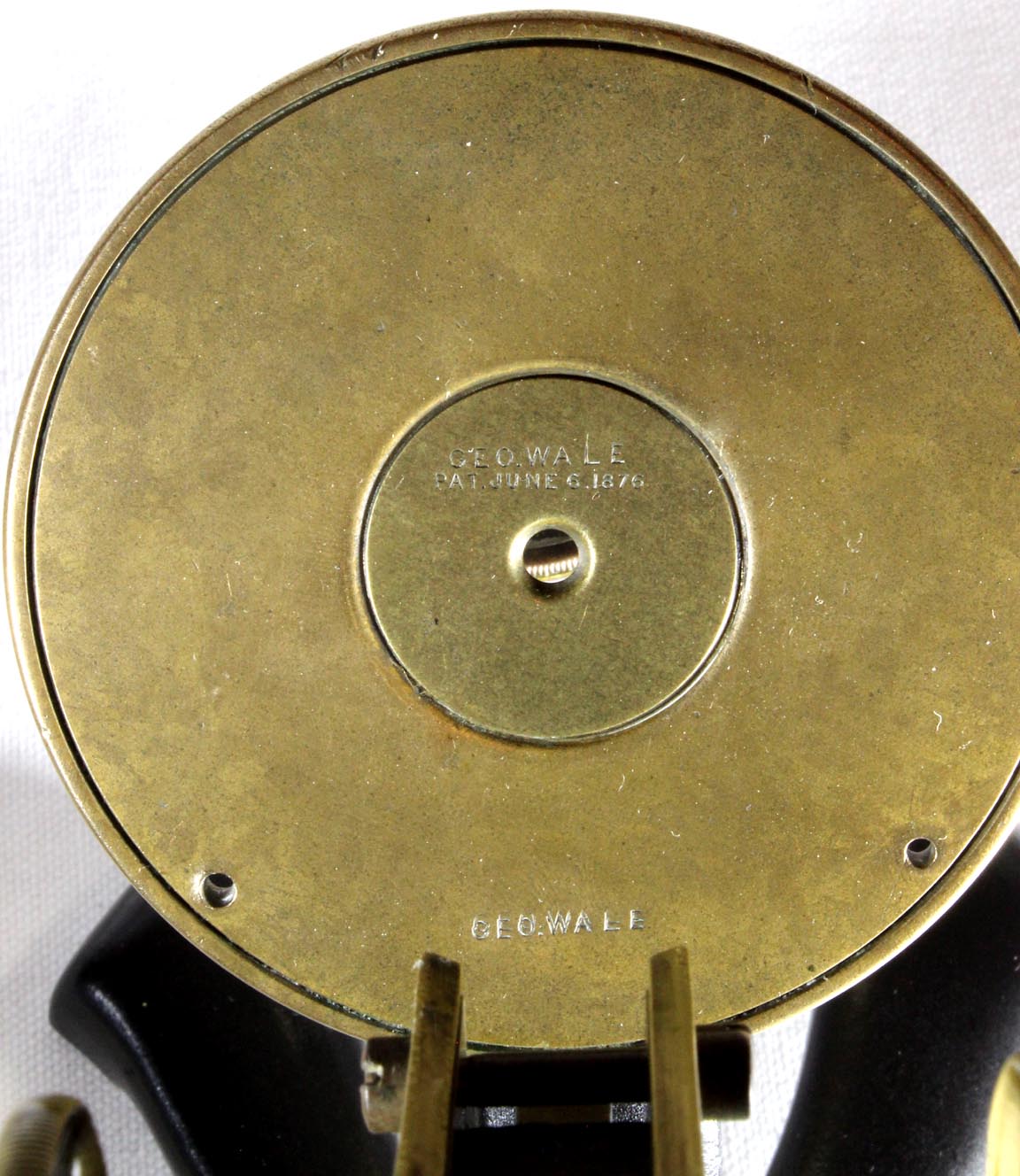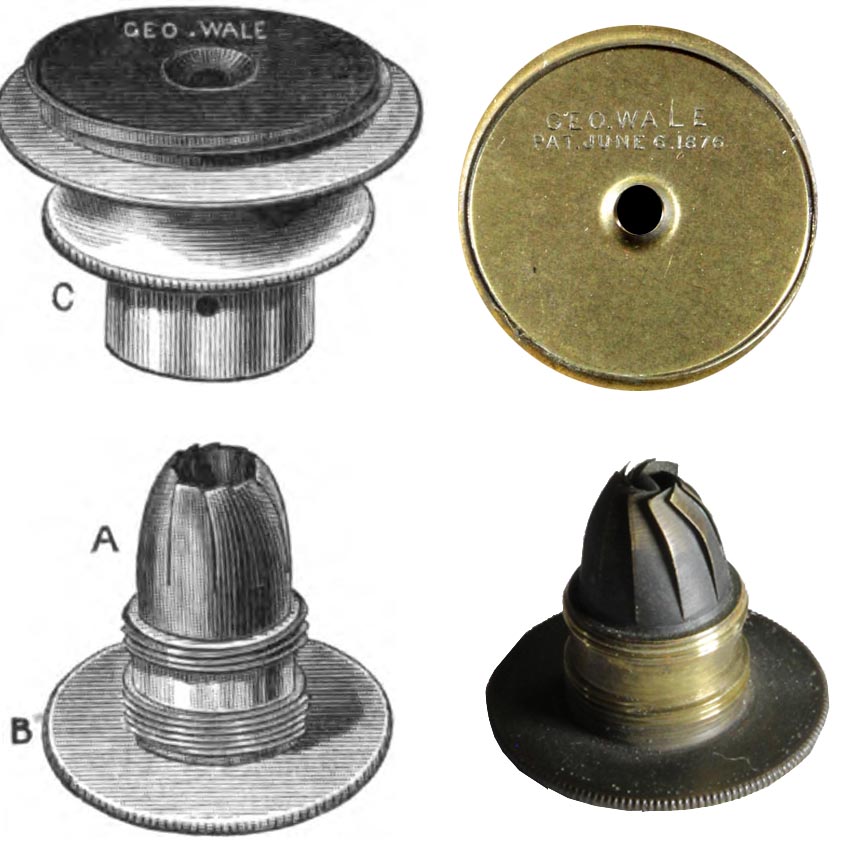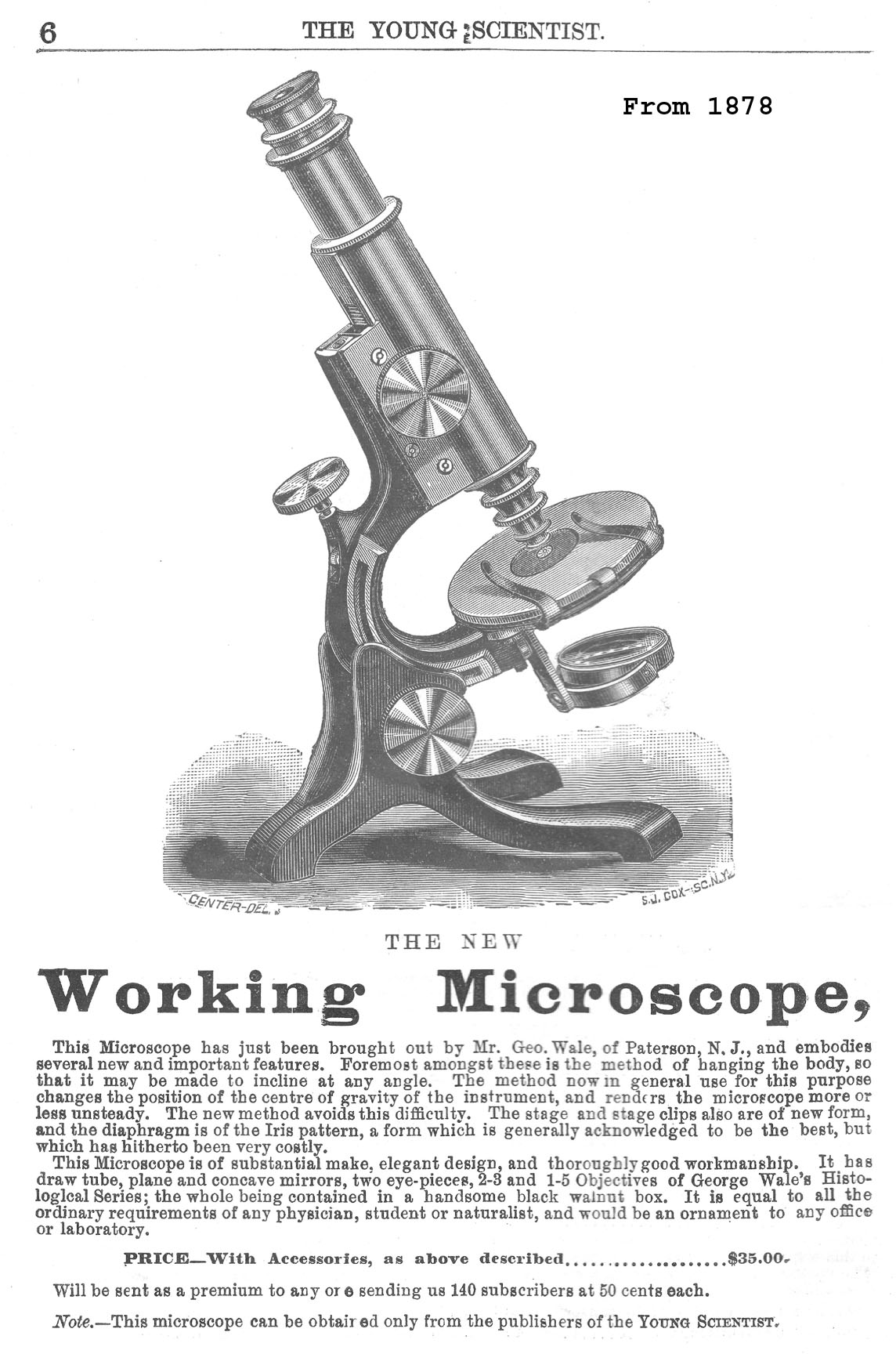MICROSCOPE-ANTIQUES.COM © 2013-15.
WALE LIMB MICROSCOPE by the inventor:
MODEL: 'NEW WORKING MICROSCOPE'
c. 1880
Maker: GEORGE WALE
Serial number: NONE
 DESCRIPTION
DESCRIPTION
 This microscope is stamped on the rear of the round stage, near the attachment to the limb 'GEO. WALE' and on the housing for the stage diaphragm it is stamped 'GEO.WALE, PAT. JUNE 6, 1876'. It is supported by a unique cast iron foot formed of two parts, each of which was cast with a groove in which slides molded sides of the cast limb. The two sides are held together by a fine screw controlled by a knurled brass knob. This knob can adjust the tension, thus allowing any position of the limb or locking it in one position. At the bottom of the C-shaped limb the stage and the swinging tailpiece are held in place by screws. The tailpiece carries a gimbaled plano-concave mirror and the piece of metal to which it is attached can slide up and down inside the tailpiece. The diaphragm is of a unique form and was the subject of the patent date associated with this instrument. The edges of its leaves are pushed up into a paraboloid shaped hollow that gets smaller as the knob is tightened. This happens as the leaves travel upward and inward guided by the shaped interior of the aperture. The stage is round and has provision for fixed stage clips via two holes. Other examples have an arrangement wherein the stage clips can rotate along the edge of the stage. Coarse focus is by straight rack and pinion, fine by lever controlled from the back of the limb and actuated by a fine threaded screw. There is a single drawtube which has a thread on its end for e.g. an erecting lens system. A single objective is signed 'Geo Wale' and there is a single unsigned ocular. Despite being of cast iron, the inclination is surprisingly smooth.
This microscope is stamped on the rear of the round stage, near the attachment to the limb 'GEO. WALE' and on the housing for the stage diaphragm it is stamped 'GEO.WALE, PAT. JUNE 6, 1876'. It is supported by a unique cast iron foot formed of two parts, each of which was cast with a groove in which slides molded sides of the cast limb. The two sides are held together by a fine screw controlled by a knurled brass knob. This knob can adjust the tension, thus allowing any position of the limb or locking it in one position. At the bottom of the C-shaped limb the stage and the swinging tailpiece are held in place by screws. The tailpiece carries a gimbaled plano-concave mirror and the piece of metal to which it is attached can slide up and down inside the tailpiece. The diaphragm is of a unique form and was the subject of the patent date associated with this instrument. The edges of its leaves are pushed up into a paraboloid shaped hollow that gets smaller as the knob is tightened. This happens as the leaves travel upward and inward guided by the shaped interior of the aperture. The stage is round and has provision for fixed stage clips via two holes. Other examples have an arrangement wherein the stage clips can rotate along the edge of the stage. Coarse focus is by straight rack and pinion, fine by lever controlled from the back of the limb and actuated by a fine threaded screw. There is a single drawtube which has a thread on its end for e.g. an erecting lens system. A single objective is signed 'Geo Wale' and there is a single unsigned ocular. Despite being of cast iron, the inclination is surprisingly smooth.
When this microscope came to me it was covered with heavily caked on thick gray spray paint. Even the lenses were coated (and etched). After some hard long work I have restored it back to close to original condition. None of the machining marks were polished off in the process, and the brass was carefully relacquered by hand, giving it an appearance as close as possible to the original.
 HISTORY OF THE WALE LIMB MICROSCOPE
HISTORY OF THE WALE LIMB MICROSCOPE
George Wale, cousin of the famous objective maker William Wales, was born in New York City in September of 1840. He apparently formed his first partnership with William Morrison about 1864 but this partnership was quickly dissolved, Morrison returning to Pike his former employer. From about 1864 to at least about 1866, and perhaps until 1871, George 'Wale' and his cousin William Wales apparently worked together. During this time they produced H.L.Smith's vertical illuminator (the patent later assigned by Smith to Wale). In this collection there is an objective can with a Bulloch Congress microscope signed W & G Wales which must date to the time the two worked together. In 1871 Wale formed a partnership with Henry Hawkins, named Hawkins and Wale
. They were working at the Stevens Institute of Technology in Hoboken, New Jersey. Signed stands with Hawkins and Wale signature are quite uncommon, but an example is in the Billings Collection and microscopes signed by retailers, but made by Hawkins and Wale are occasionally found, being identical to signed examples. In 1878, the partnership was terminated, and George Wale left the Stevens institute. That same year he came out with the microscope pictured on this page, apparently selling via the Industrial Publication Company. Although William Wales exclusively made objectives, George and likely his partners, in addition to microscopes, also made objectives.
George Wale was an acknowledged innovator of microscope design and his most famous innovation is the Wale Limb
as first shown on this model. It was first marketed in 1878, as shown in the advertisement from 'The Young Scientist from November of 1878. Despite the impressive design, a patent for the inclination joint itself was never granted, allowing many makers to copy it; for this reason some earlier examples of this stand have 'Patent Applied For' stamped at the rear of the stage rather than just George Wale's name. This example obviously dates from the time that the patent protection was denied, as it no longer mentions a patent applied for, only noting the patent for the diaphragm (also found on the earlier examples). Marketing of this microscope was between the Industrial Publication Company (IPC), headed by John Phin. The IPC advertised itself as the sole distributor of this stand. The microscope was sold for $35 with two 'Histological Series objectives, oculars, and case. At the same time, a 'Twenty Dollar' microscope, made by Bausch & Lomb was also marketed. The $20 stand had no fine focus and had only the usual form of inclination joint, but was still a very serviceable microscope.
Because it allowed the center of gravity to remain in a well-supported position, this type of limb was copied and supplied, sometimes with dramatic flair, by many other makers. Bausch and Lomb supplied their 'Concentric' model using a variant of this limb. Swift used it on many stands, an example of which, is the 'Swift Improved Wales Limb Microscope'on this website. Ross produced the 'Wenham Radial' which was likely the most complicated version. The design received high praise and continued to be used on some models by Swift for many years as seen on the Swift Paragon Model from 1891 to about 1910, and in later in the 20th century by the 'Symposium Research' Model, a complicated modern
microscope of impressive stability. The latter used ball bearings to provide a smooth gliding mechanism during inclination.
Wale apparently sold his business to Bausch & Lomb in 1880, which accounts for the relatively small number of surviving stands of the 'New Working Microscope' since they were only made from late 1878 to sometime in 1880. B & L did not continue this model once they took over, but by 1886 was producing a model they called the 'New Student Microscope' with a Wale limb. They also sold microscopes using George Wale's patented diaphragm. George Wale died about 1903.
For further details on the life and work of George Wale, please see the George Wale entry on the Microscopist.net website by Brian Stevenson.
 DESCRIPTION
DESCRIPTION This microscope is stamped on the rear of the round stage, near the attachment to the limb 'GEO. WALE' and on the housing for the stage diaphragm it is stamped 'GEO.WALE, PAT. JUNE 6, 1876'. It is supported by a unique cast iron foot formed of two parts, each of which was cast with a groove in which slides molded sides of the cast limb. The two sides are held together by a fine screw controlled by a knurled brass knob. This knob can adjust the tension, thus allowing any position of the limb or locking it in one position. At the bottom of the C-shaped limb the stage and the swinging tailpiece are held in place by screws. The tailpiece carries a gimbaled plano-concave mirror and the piece of metal to which it is attached can slide up and down inside the tailpiece. The diaphragm is of a unique form and was the subject of the patent date associated with this instrument. The edges of its leaves are pushed up into a paraboloid shaped hollow that gets smaller as the knob is tightened. This happens as the leaves travel upward and inward guided by the shaped interior of the aperture. The stage is round and has provision for fixed stage clips via two holes. Other examples have an arrangement wherein the stage clips can rotate along the edge of the stage. Coarse focus is by straight rack and pinion, fine by lever controlled from the back of the limb and actuated by a fine threaded screw. There is a single drawtube which has a thread on its end for e.g. an erecting lens system. A single objective is signed 'Geo Wale' and there is a single unsigned ocular. Despite being of cast iron, the inclination is surprisingly smooth.
This microscope is stamped on the rear of the round stage, near the attachment to the limb 'GEO. WALE' and on the housing for the stage diaphragm it is stamped 'GEO.WALE, PAT. JUNE 6, 1876'. It is supported by a unique cast iron foot formed of two parts, each of which was cast with a groove in which slides molded sides of the cast limb. The two sides are held together by a fine screw controlled by a knurled brass knob. This knob can adjust the tension, thus allowing any position of the limb or locking it in one position. At the bottom of the C-shaped limb the stage and the swinging tailpiece are held in place by screws. The tailpiece carries a gimbaled plano-concave mirror and the piece of metal to which it is attached can slide up and down inside the tailpiece. The diaphragm is of a unique form and was the subject of the patent date associated with this instrument. The edges of its leaves are pushed up into a paraboloid shaped hollow that gets smaller as the knob is tightened. This happens as the leaves travel upward and inward guided by the shaped interior of the aperture. The stage is round and has provision for fixed stage clips via two holes. Other examples have an arrangement wherein the stage clips can rotate along the edge of the stage. Coarse focus is by straight rack and pinion, fine by lever controlled from the back of the limb and actuated by a fine threaded screw. There is a single drawtube which has a thread on its end for e.g. an erecting lens system. A single objective is signed 'Geo Wale' and there is a single unsigned ocular. Despite being of cast iron, the inclination is surprisingly smooth.  HISTORY OF THE WALE LIMB MICROSCOPE
HISTORY OF THE WALE LIMB MICROSCOPE